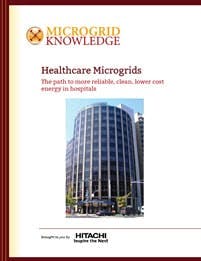This is third article in a series that examines the healthcare microgrid and its value to medical facilities that want to lower cost energy costs and improve electric reliability.
Download the full report now
During the Northeast blackout of 2003 half of New York City’s 58 hospitals suffered failures in their back-up power generators, according to the U.S. Environmental Protection Agency. When hospital back-up power fails, as happened again in some Northeast hospitals in 2012 during Superstorm Sandy, patients must be evacuated to other facilities, creating a chain-of-care nightmare for the patients, their families and caregivers at all facilities. And this comes at a time when people are seeking care from injuries, some very serious, caused by the storm.
Consider the overwhelming pressure put on one hospital during Superstorm Sandy. Flooding and generator failures “led to the unprecedented evacuation and closure of all hospitals in the lower half of Manhattan except for Beth Israel Medical Center,” according to a study published by Frontiers in Public Health. The only hospital to withstand the storm, Beth Israel, saw ambulance arrivals spike by 64 percent in the four weeks following the storm. Emergency room visits jumped from an average 300 per day to 500 per day in the first week. The hospital set up satellites and even opened beds in a detox center for patients. But it still could not accommodate the overwhelming need. Lines formed out the door, and the hospital saw a three-fold increase of ambulance patients “left without being seen,” said the study.
The pressure on hospitals during storms gets worse as other kinds of medical facilities lose power. The hospital becomes the health services fallback, creating an added burden at a tough time. Hospitals with working power become inundated. Patients arrive not only from neighboring hospitals, but also from other care facilities —satellites, walk-in medical clinics, nursing homes, retirement care facilities—that have lost power. The flood of patients can overwhelm the hospital’s resources.
Installing a microgrid at the main hospital may not be enough to ensure stable patient care in a crisis. Communities need to look at their entire healthcare chain.
“If the satellite facilities are not resilient, they put their medical and healthcare load back on the hospital. In a major storm, the healthcare system can be crushed under its own weight,” Pullins said.
That is why it’s important for healthcare professionals and community leaders to think holistically about their power supply. Installing a microgrid at the main hospital may not be enough to ensure stable patient care in a crisis. Communities need to look at their entire healthcare chain.
Infusing genius into generators
Government has tightened regulations for hospitals over the years in an attempt to avoid the power outage nightmares exemplified in New York in 2003 and 2012.
In the U.S., back-up generators must be tested on a regular schedule, generally monthly, annually and then every three years for four hours, depending on circumstances. But back-up generators still have clear limitations. Because they infrequently use the generators, hospitals may be unaware that they no longer work until they need the generators in a sudden crisis.
“A healthcare microgrid is truly a new energy business model for your hospital, one that encompasses your electric utility, your back-up generators, and your new on-site supply, all configured with a dynamic software intelligence. The microgrid tends to your energy needs and energy budget while you tend to your core business.” – Steve Pullins, vice president of energy solutions at Hitachi America
The condition of a microgrid, however, is transparent since it’s always in operation. So it can complement back-up generators by adding additional redundancy of supply. When a hospital installs a microgrid, it goes from having one form of backup, likely a diesel or natural gas generator, to multiple kinds of backup, solar, energy storage, CHP etc.
In fact, as Hitachi’s Pullins points out, healthcare microgrids really shouldn’t be thought of as back-up generation at all, but as a highly advanced complement to both back-up generators and utility services.
“Microgrids are a replacement for certain utility services at certain times, not a replacement for the back-up generator,” he said. “A healthcare microgrid is truly a new energy business model for your hospital, one that encompasses your electric utility, your back-up generators, and your new on-site supply, all configured with a dynamic software intelligence. The microgrid tends to your energy needs and energy budget while you tend to your core business.”
[clickToTweet tweet=”#Microgrid controllers allow hospitals to pursue energy planning in a new and sophisticated way. ” quote=”#Microgrid controllers allow hospitals to pursue energy planning in a new and sophisticated way. “]
This intelligence arises from the microgrid controller, ‘the brain’ of the microgrid. The controller transforms what would otherwise be ‘dumb’ generation—the straightforward production of megawatts—into a dynamic configuration of resources. The controller can leverage multiple technologies for multiple purposes with no human intervention, and all at lightning fast speed.
For example, the controller can:
- Serve a facility on a standalone basis or configure with the central utility grid
- Seamlessly switch the facility from grid power to the microgrid and back again
- Determine which resources to use at any point in time based on building load and electricity prices
- Plan into the future, taking into account factors such as weather, which is important for wind and solar energy, as well as understanding if the weather trend may challenge the local grid
- Leverage the hospital’s electric and heat loads for best pricing
- Sell services to the central grid, creating a revenue stream for the healthcare facility
- Manage the variable output of renewable resources. For example, the microgrid controller can ensure that the energy storage system or CHP seamlessly takes over when wind power or solar energy production ebbs
- Manage resources toward achieving hospital sustainability goals
Microgrid controllers—and the genius that they infuse into generation—allow hospitals to pursue energy planning in a new and sophisticated way. The result is an energy system that enhances energy reliability, efficiency and budget. Microgrids also assist hospitals in their pursuit of sustainability goals, as we explain in the next chapter.
Over the next few weeks we will also cover:
- What Makes Healthcare Microgrids Efficient and Green?
- The No Money Down Healthcare Microgrid
- Profiles of Real World Healthcare Microgrids
- Why Healthcare Microgrids are Important to Communities
- The Value of Healthcare Microgrids
For more on healthcare microgrids, see the guide “HealthCare Microgrids: The Path to More Reliable, Clean, Lower Cost Energy in Hospitals,” downloadable free of charge courtesy of Hitachi.







